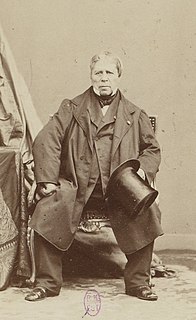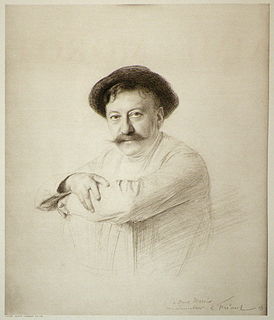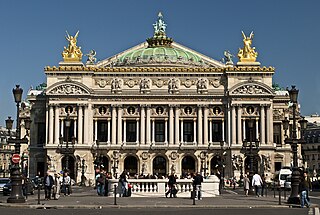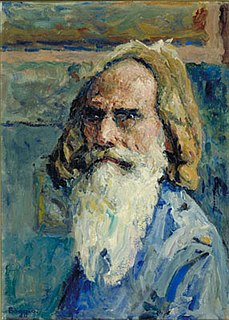
Oscar-Claude Monet was a French painter and founder of impressionist painting who is seen as a key precursor to modernism, especially in his attempts to paint nature as he perceived it. During his long career, he was the most consistent and prolific practitioner of impressionism's philosophy of expressing one's perceptions before nature, especially as applied to plein air (outdoor) landscape painting. The term "Impressionism" is derived from the title of his painting Impression, soleil levant, exhibited in the 1874 initiated by Monet and his associates as an alternative to the Salon.

Édouard Manet was a French modernist painter. He was one of the first 19th-century artists to paint modern life, as well as a pivotal figure in the transition from Realism to Impressionism.

Jean-François Millet was a French artist and one of the founders of the Barbizon school in rural France. Millet is noted for his paintings of peasant farmers and can be categorized as part of the Realism art movement. Toward the end of his career he became increasingly interested in painting pure landscapes. He is known best for his oil paintings but is also noted for his pastels, conte crayon drawings, and etchings.

Jean-Auguste-Dominique Ingres was a French Neoclassical painter. Ingres was profoundly influenced by past artistic traditions and aspired to become the guardian of academic orthodoxy against the ascendant Romantic style. Although he considered himself a painter of history in the tradition of Nicolas Poussin and Jacques-Louis David, it is his portraits, both painted and drawn, that are recognized as his greatest legacy. His expressive distortions of form and space made him an important precursor of modern art, influencing Picasso, Matisse and other modernists.

Jean Désiré Gustave Courbet was a French painter who led the Realism movement in 19th-century French painting. Committed to painting only what he could see, he rejected academic convention and the Romanticism of the previous generation of visual artists. His independence set an example that was important to later artists, such as the Impressionists and the Cubists. Courbet occupies an important place in 19th-century French painting as an innovator and as an artist willing to make bold social statements through his work.

Henri Julien Félix Rousseau was a French post-impressionist painter in the Naïve or Primitive manner. He was also known as Le Douanier, a humorous description of his occupation as a toll and tax collector. He started painting seriously in his early forties; by age 49, he retired from his job to work on his art full-time.

Francisco Oller was a Puerto Rican painter. Oller is the only Latin American painter to have played a role in the development of Impressionism. One of the most distinguished transatlantic painters of his day, Oller helped transform painting in the Caribbean.

Maurice de Vlaminck was a French painter. Along with André Derain and Henri Matisse, he is considered one of the principal figures in the Fauve movement, a group of modern artists who from 1904 to 1908 were united in their use of intense colour. Vlaminck was one of the Fauves at the controversial Salon d'Automne exhibition of 1905.

San Miguel is a department in the eastern part of El Salvador. The capital is San Miguel. The department is 2,077 km² in area and has a population of over 678,000.

The Salon, or rarely Paris Salon, beginning in 1667 was the official art exhibition of the Académie des Beaux-Arts in Paris. Between 1748 and 1890 it was arguably the greatest annual or biennial art event in the Western world. At the 1761 Salon, thirty-three painters, nine sculptors, and eleven engravers contributed. From 1881 onward, it has been managed by the Société des Artistes Français.

Le Déjeuner sur l'herbe – originally titled Le Bain – is a large oil on canvas painting by Édouard Manet created in 1862 and 1863. It depicts a female nude and a scantily dressed female bather on a picnic with two fully dressed men in a rural setting. Rejected by the Salon jury of 1863, Manet seized the opportunity to exhibit this and two other paintings in the 1863 Salon des Refusés, where the painting sparked public notoriety and controversy. The work is now in the Musée d'Orsay in Paris. A smaller, earlier version can be seen at the Courtauld Gallery, London.

Jacques Joseph Tissot, anglicized as James Tissot, was a French painter and illustrator. He was a successful painter of fashionable, modern scenes and society life in Paris before moving to London in 1871. A friend and mentor of Edgar Degas, Tissot also painted scenes and figures from the Bible.

Aimé Nicolas Morot was a French painter and sculptor in the Academic Art style.

Second Empire style, also known as the Napoleon III style, was a highly eclectic style of architecture and decorative arts, which used elements of many different historical styles, and also made innovative use of modern materials, such as iron frameworks and glass skylights. It flourished during the reign of Emperor Napoleon III in France (1852–1871) and had an important influence on architecture and decoration in the rest of Europe and North America. Major examples of the style include the Opéra Garnier (1862–1871) in Paris by Charles Garnier, the Bibliothèque nationale de France, the Church of Saint Augustine (1860–1871), and the Philadelphia City Hall. The architectural style was closely connected with Haussmann's renovation of Paris carried out during the Second Empire; the new buildings, such as the Opéra, were intended as the focal points of the new boulevards.
Agustín Lazo Adalid was a Mexican artist and playwright who is credited with introducing surrealism to Mexico. Although he grew up during the era of the Mexican Revolution, his time in Europe in the 1920s and early 1930s, set his aesthetics towards the avant-garde movements of that continent, rather than towards Mexican muralism, making him a part of the Los Contemporáneos or “Grupo sin grupo.” His work in art and theater influenced each other, with his art having theatrical themes and his theater having emphasis on sets and visual cues. Lazo retired from art in 1950, after the death of his long-time partner poet Xavier Villaurrutia, supposedly never painting or writing again.

Manuel Rodríguez Lozano was a Mexican painter, known for his “melancholy” depiction of Mexico rather than the more dominant political or festive one of the Mexican muralism movement. This is especially true of his “white stage” which is marked by cold colors and tragic scenes focusing on human figures which are skeletal or ghost-like. His work influenced Mexican films such as La perla.
Jorge Piqueras was a Peruvian-born visual artist. He is recognized as one of the most important Peruvian artists of the twentieth century. Among contemporary Latin American artists, he is also a pioneer in geometric painting. Piqueras’ work covers a wide range of materials and media, including sculpture, painting, collage, photography and assemblage.

Emilio Boggio was an Italian-Venezuelan pioneering impressionist painter. In 1864 he traveled to France and studied at the Lycée Michelet in Paris until 1870. In 1873, he returned to Caracas and dedicated himself to the family business. In 1877, he returned to France to join the Académie Julian where he received lessons from Jean-Paul Laurens. In 1888, obtained a Hors Concours at the Salon of the Société des Artistes Français and in 1889, was awarded a bronze medal at the Exposition Universelle in Paris.
Paul-Léon Jazet was a French painter born in Paris, the son of the engraver Alexandre-Jean-Louis Jazet. For much of his career, he was mostly known for genre scenes, portraits and military subjects.

Ahmed Sabri, sometimes Ahmad Sabry was an Egyptian painter born in Cairo. He was one of the most prominent pioneers of modern portraiture art in Egypt.
















